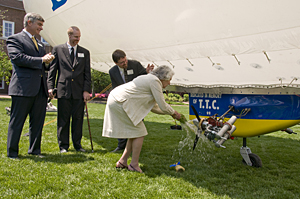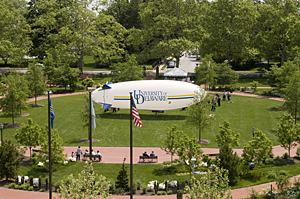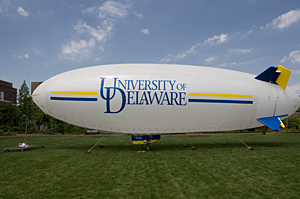
- Rozovsky wins prestigious NSF Early Career Award
- UD students meet alumni, experience 'closing bell' at NYSE
- Newark Police seek assistance in identifying suspects in robbery
- Rivlin says bipartisan budget action, stronger budget rules key to reversing debt
- Stink bugs shouldn't pose problem until late summer
- Gao to honor Placido Domingo in Washington performance
- Adopt-A-Highway project keeps Lewes road clean
- WVUD's Radiothon fundraiser runs April 1-10
- W.D. Snodgrass Symposium to honor Pulitzer winner
- New guide helps cancer patients manage symptoms
- UD in the News, March 25, 2011
- For the Record, March 25, 2011
- Public opinion expert discusses world views of U.S. in Global Agenda series
- Congressional delegation, dean laud Center for Community Research and Service program
- Center for Political Communication sets symposium on politics, entertainment
- Students work to raise funds, awareness of domestic violence
- Equestrian team wins regional championship in Western riding
- Markell, Harker stress importance of agriculture to Delaware's economy
- Carol A. Ammon MBA Case Competition winners announced
- Prof presents blood-clotting studies at Gordon Research Conference
- Sexual Assault Awareness Month events, programs announced
- Stay connected with Sea Grant, CEOE e-newsletter
- A message to UD regarding the tragedy in Japan
- More News >>
- March 31-May 14: REP stages Neil Simon's 'The Good Doctor'
- April 2: Newark plans annual 'wine and dine'
- April 5: Expert perspective on U.S. health care
- April 5: Comedian Ace Guillen to visit Scrounge
- April 6, May 4: School of Nursing sponsors research lecture series
- April 6-May 4: Confucius Institute presents Chinese Film Series on Wednesdays
- April 6: IPCC's Pachauri to discuss sustainable development in DENIN Dialogue Series
- April 7: 'WVUDstock' radiothon concert announced
- April 8: English Language Institute presents 'Arts in Translation'
- April 9: Green and Healthy Living Expo planned at The Bob
- April 9: Center for Political Communication to host Onion editor
- April 10: Alumni Easter Egg-stravaganza planned
- April 11: CDS session to focus on visual assistive technologies
- April 12: T.J. Stiles to speak at UDLA annual dinner
- April 15, 16: Annual UD push lawnmower tune-up scheduled
- April 15, 16: Master Players series presents iMusic 4, China Magpie
- April 15, 16: Delaware Symphony, UD chorus to perform Mahler work
- April 18: Former NFL Coach Bill Cowher featured in UD Speaks
- April 21-24: Sesame Street Live brings Elmo and friends to The Bob
- April 30: Save the date for Ag Day 2011 at UD
- April 30: Symposium to consider 'Frontiers at the Chemistry-Biology Interface'
- April 30-May 1: Relay for Life set at Delaware Field House
- May 4: Delaware Membrane Protein Symposium announced
- May 5: Northwestern University's Leon Keer to deliver Kerr lecture
- May 7: Women's volleyball team to host second annual Spring Fling
- Through May 3: SPPA announces speakers for 10th annual lecture series
- Through May 4: Global Agenda sees U.S. through others' eyes; World Bank president to speak
- Through May 4: 'Research on Race, Ethnicity, Culture' topic of series
- Through May 9: Black American Studies announces lecture series
- Through May 11: 'Challenges in Jewish Culture' lecture series announced
- Through May 11: Area Studies research featured in speaker series
- Through June 5: 'Andy Warhol: Behind the Camera' on view in Old College Gallery
- Through July 15: 'Bodyscapes' on view at Mechanical Hall Gallery
- More What's Happening >>
- UD calendar >>
- Middle States evaluation team on campus April 5
- Phipps named HR Liaison of the Quarter
- Senior wins iPad for participating in assessment study
- April 19: Procurement Services schedules information sessions
- UD Bookstore announces spring break hours
- HealthyU Wellness Program encourages employees to 'Step into Spring'
- April 8-29: Faculty roundtable series considers student engagement
- GRE is changing; learn more at April 15 info session
- April 30: UD Evening with Blue Rocks set for employees
- Morris Library to be open 24/7 during final exams
- More Campus FYI >>
4:21 p.m., May 12, 2009----More than 75 members of the University of Delaware community cheered as alumna Rachel Jewett Ledbetter, '44AS, broke a bottle of faux champagne over the gondola of UD's new non-rigid airship at a dedication ceremony May 12.
“I wish those who work with it great success and satisfaction with the studies that evolve, and I hope it measures up to your expectations,” she said.
Ledbetter donated the funds for the University to purchase the 60-foot long, remote-controlled airship, which will be used as an environmental research and monitoring platform.
The dirigible is dedicated to the memory of Ledbetter's grandfather, Thomas Tustin Cloward, who enabled her to attend the University while her family lived in Honduras. His initials appear in blue on the vehicle's gondola.
In opening the dedication ceremony, University President Patrick Harker said, “We are clearly indebted to Michael O'Neal, assistant professor of geography, and Jack Puleo, assistant professor of civil engineering, the two lead faculty on this project. This was their dream, their labor of love, and now their reality.”
“This airship is an exciting addition to a series of instruments and innovations that further UD's reputation as a bold leader in environmental research, technology, and education,” he continued. “I look forward to its upcoming missions and the data it will bring back -- data that will improve our environmental science and, ultimately, our environmental policy.”
Harker thanked not only O'Neal and Puleo for their vision and Ledbetter for her generosity, but also the deans of the four colleges involved -- Tom Apple, Arts and Sciences; Nancy Targett, Marine and Earth Studies; Michael Chajes, Engineering; and Robin Morgan, Agriculture and Natural Resources. The colleges have provided funds for accessories, including the trailer used to transport the blimp when it is deflated.
"A hallmark of environmental research and education is the breadth and complexity of the types of questions that it addresses," Targett said. "Environmental research is inherently multidisciplinary, and therefore it draws together scientists, engineers, and policy analysts to address the complex issues that transcend traditional disciplinary lines."
“The UD airship joins a fleet of innovative vehicles and instruments that contribute to our environmental research,” she continued, “and can be found in units across the campus -- the fuel-cell powered bus, innovative solar panel designs, the V2G-enabled electric car, the new agricultural research combine, our state-of-the-art research vessel, underwater gliders, and fixed buoys -- the list goes on and on. With the airship joining that list, UD has a presence not only on land and at sea, but in the air as well.”
O'Neal, who had the original vision for the airship as a cost-effective way to gather data about the Earth, said that it has already been used by the Delaware Geological Survey (DGS) to observe the influence of changes in the estuarine environment due to the mixing of saline and freshwater.
“Every week, someone at UD comes up with a new idea for how to use the airship,” he said, “and we couldn't be happier. We didn't get it to use for ourselves -- we got it to use for the University. The data collected by DGS has already been brought into the classroom, where students are benefiting from it.”
The airship's interchangeable payload design enables it to be equipped with a variety of imaging instrumentation, including a laser scanner and visible, ultraviolet, and infrared cameras.
Depending on the instrumentation used, researchers will be able to capture data and analyze land-use and land-cover change, geomorphology, climate variability, coastal processes, landfill chemistry, and various other environmental phenomena.
Article by Diane Kukich
Photos by Evan Krape




